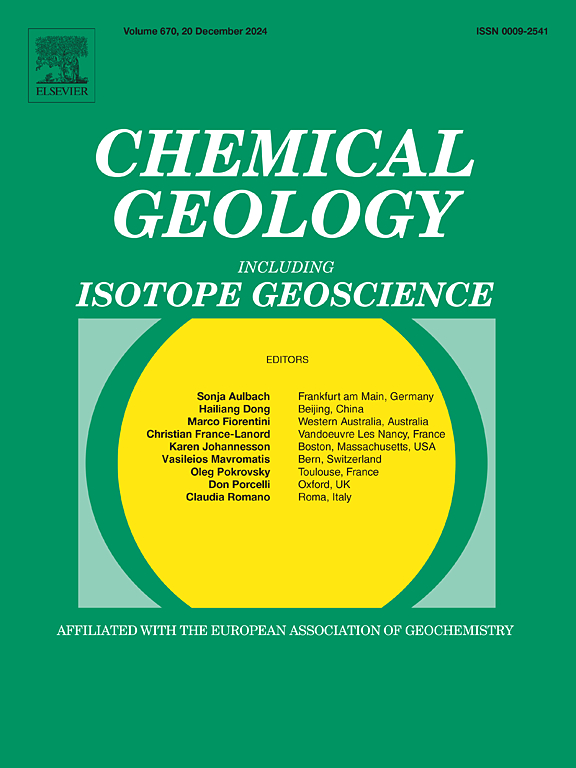低温洞穴碳酸盐:来自高山冰洞的新见解
IF 3.6
2区 地球科学
Q1 GEOCHEMISTRY & GEOPHYSICS
引用次数: 0
摘要
低温洞穴碳酸盐(CCC)是在冰冻条件下形成的岩浆岩,为了解过去的寒冷环境和低温过程提供了重要信息。传统上,CCC 被分为两类:细粒度 CCC(以下简称 CCC-f)和粗粒度 CCC(以下简称 CCC-c),主要依据是颗粒大小和稳定同位素组成。然而,最近在奥地利高山冰洞中的观察结果表明,还存在一个中间类别,即 CCC-i,其特点是粒度较小(1 毫米),稳定同位素值与 CCC-c 重叠。本研究记录了在七个冰洞中发现的 CCC-i 的出现、形态和稳定同位素组成,为了解其形成机制提供了线索。CCC-i 与冰中的小水池有关,在洞穴气候中形成,这种气候介于洞穴入口附近的完全异温状态和洞穴内部通道的同温状态之间,具有热稳定性高的特点。CCC-i 的稳定同位素特征显示了与 CCC-c 相似的雷利型分馏过程,但时空尺度较小。这项研究强调了 CCC-i 在古气候方面的重要意义,因为它们可以改善对过去洞穴冰川的重建。然而,气候变暖导致洞穴冰川不断后退,威胁着 CCC 沉积物的保存,因此强调了进一步研究的紧迫性。本文章由计算机程序翻译,如有差异,请以英文原文为准。
Cryogenic cave carbonates: New insights from alpine ice caves
Cryogenic cave carbonates (CCC) are speleothems that form under freezing conditions and provide crucial insights into past cold environments and cryogenic processes. Traditionally, CCC have been classified into two categories: fine-grained CCC (hereafter CCC-f) and coarse-grained CCC (hereafter CCC-c), primarily based on particle size and stable isotopic composition. However, recent observations from alpine ice caves in Austria suggest the existence of an intermediate class, termed CCC-i, characterized by small grain sizes (<1 mm) and stable isotope values that overlap with CCC-c. This study documents the occurrence, morphology, and stable isotopic composition of CCC-i found in seven ice caves, providing insights into their formation mechanism. CCC-i are associated with small pools in ice and form in a cave climate that is transitional between the fully heterothermic regime close to the entrance and the homothermic regime of the inner cave passages characterized by high thermal stability. The stable isotopic signatures of CCC-i indicate a Rayleigh-type fractionation process similar to CCC-c but at a smaller spatial and temporal scale. This study highlights the paleoclimatic significance of CCC-i, as they may improve reconstructions of past cave glaciations. However, the ongoing retreat of cave ice due to climate warming threatens the preservation of CCC deposits, emphasizing the urgency of further research.
求助全文
通过发布文献求助,成功后即可免费获取论文全文。
去求助
来源期刊

Chemical Geology
地学-地球化学与地球物理
CiteScore
7.20
自引率
10.30%
发文量
374
审稿时长
3.6 months
期刊介绍:
Chemical Geology is an international journal that publishes original research papers on isotopic and elemental geochemistry, geochronology and cosmochemistry.
The Journal focuses on chemical processes in igneous, metamorphic, and sedimentary petrology, low- and high-temperature aqueous solutions, biogeochemistry, the environment and cosmochemistry.
Papers that are field, experimentally, or computationally based are appropriate if they are of broad international interest. The Journal generally does not publish papers that are primarily of regional or local interest, or which are primarily focused on remediation and applied geochemistry.
The Journal also welcomes innovative papers dealing with significant analytical advances that are of wide interest in the community and extend significantly beyond the scope of what would be included in the methods section of a standard research paper.
 求助内容:
求助内容: 应助结果提醒方式:
应助结果提醒方式:


